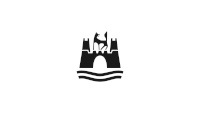Municipal gallery
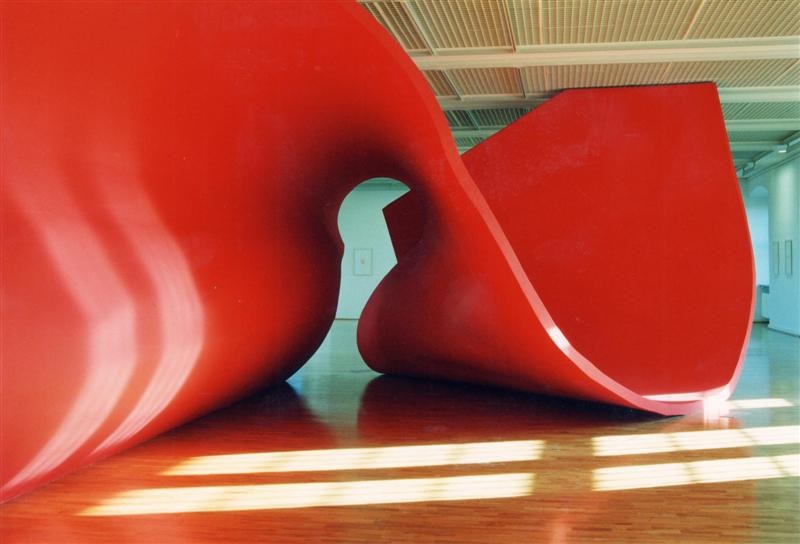
The Städtische Galerie Wolfsburg sees itself as a living museum in dialogue with its visitors. As a place of reflection and active participation in the sense of discerning observation, it conveys the meaningful potential of art. The preservation and expansion of the collection of contemporary art and the educational mission are our primary goals. With its program, the Städtische Galerie has been contributing to the intellectual and cultural identity of the city of Wolfsburg since 1974.
The founding impulse for the establishment of the Städtische Galerie Wolfsburg was the desire to develop social impact through artistic production. It is therefore important to offer artists the opportunity to work freely in our gallery and to support this work in the long term. In the Städtische Galerie, artists thematize and update the thinking of the present in ever new ways through the presentation of their works and dare to look beyond the boundaries of everyday life. Artistic experimentation, production as well as research are responsibly and sustainably promoted by us and are reflected in the exhibitions as well as in the collection.
A highlight of the exhibition program is the awarding of the art prize "Junge Stadt sieht Junge Kunst" (Young City sees Young Art), which is one of the oldest traditions of cultural life in Wolfsburg and is awarded every three years. The prize was established in 1959 and according to the principles of the award, the prize is awarded to artists who "have gained national attention and a corresponding degree of recognition with their previous work and are to be promoted in their artistic work with this prize". In recent years, recipients have included Thomas Schütte, Katharina Fritsch, Olaf Nicolai, Bernhard Martin, Bettina Pousttchi and Julius von Bismarck. In October 2020, the art prize will be presented to Birgit Brenner. The exhibition at the Städtische Galerie Wolfsburg associated with the award ceremony, as well as the publication, will enable the public to engage more deeply with the work of the award winner and emphasize its promotional character.
Our house and our offers are open to all, admission is deliberately free of charge. The location in Wolfsburg Castle, an unmistakable place with an aura, and the interaction with the other events taking place here offer a unique and very special ambience for encounters - not only with the expressions of art, but also with other people. All offers have the personal address and the creative exchange with each other as a goal.
-
45 years Municipal Gallery
Michael Müller "DEINE KUNST" Presentation of the collection in several versions.
First version: "YOUR ART: THE CRISIS OF THE CITIES GALLERY OF WOLFSBURG: solution or resolution / THE LIQUIDATOR" from February 8 to April 7, 2019.
Second version: "The Art(ist) is Present / THE AUTHOR'S DEATH WILL NOT BE ALLOWED" from May 18 to October 6, 2019.
Third version: "The Conditions of Being Art (or the Amateur)" from October 19, 2019 to April 5, 2020.
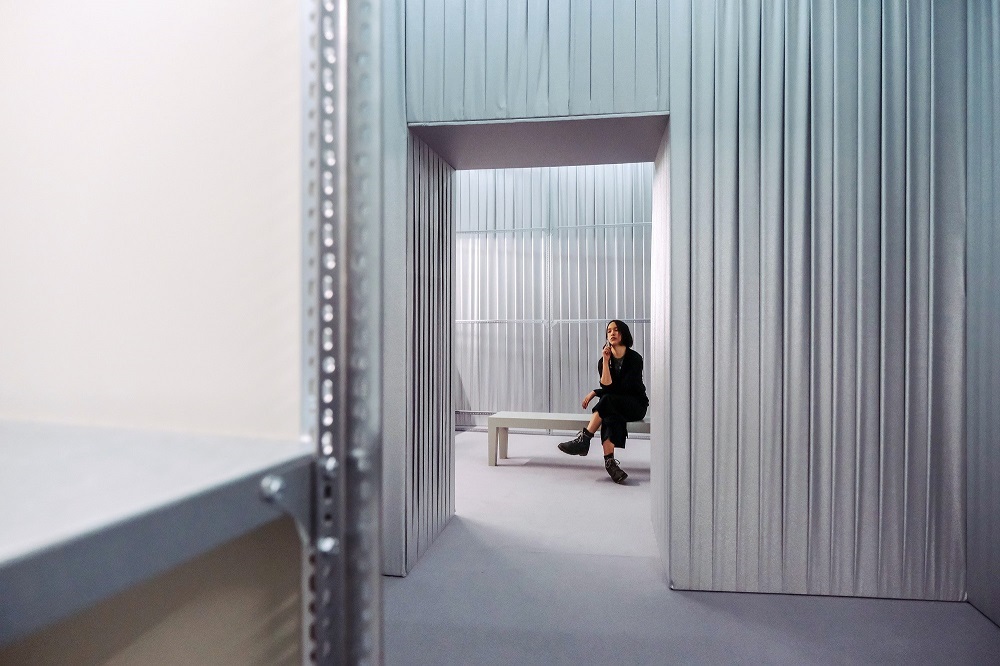 "YOUR ART" An installation by Michael Müller in the west wing of Wolfsburg Castle © Michael Müller/VG Bild-Kunst, Bonn 2019, Photo: Janina Snatzke
"YOUR ART" An installation by Michael Müller in the west wing of Wolfsburg Castle © Michael Müller/VG Bild-Kunst, Bonn 2019, Photo: Janina SnatzkeTo mark the 45th anniversary of the Städtische Galerie Wolfsburg, which was founded on October 20, 1974, it is showing an unusual, multi-part new presentation of its collection. Berlin-based artist Michael Müller (*1970) was invited to make a personal selection from the holdings and stage the chosen works for the public for two years in the west wing of the castle. Michael Müller decided not to show only one exhibition, but to present the collection in several successive versions and changing contexts, which set different formal as well as thematic emphases. The individual versions are curated in a sometimes eccentric and extremely "work-like" manner. Even the exhibition spaces are gradually changed down to the smallest detail by Michael Müller and his team.
Among other things, the entrance area will be equipped with a "museum store" that will house 500 (!) books over the course of the series, newly produced especially for the exhibition. The walls of the rooms are covered with gray cloth; the rooms themselves remain strangely empty. From the second frame on, an echo sounder echoes in the stairwell, lonely, as if searching for a meaning. (An echo sounder is used for navigation at sea and for measuring the depth of the sea. Sound impulses are emitted, reflected, and returned to their point of origin). The opening version of the collection presentation was also to be walked through with soundproof headphones, which could be borrowed at the entrance. To be contemplated were thus silent spaces of possibility, perimeters, frames, stages.
And from the second version, the sound installation "Who speaks?" (The Voices) will be presented in the Silberkeller. The audio installation is based on a manuscript of 12 chapters arranged as an inner dialogue and was recorded in German and English by an actress as a radio play. Distributed on 12 podiums, the voice wanders through the room.
Also in the second version were small signs containing information about individual works: Name, title, year, dimensions, materials, etc. were listed matter-of-factly, and in many cases supplemented by a number given to the work in the accompanying audio guide. And the audio guide was at the center of the greatly reduced presentation. For the works it was supposed to accompany were missing. The works were not shown!
In the end, very little remains "as it was". There are countless questions in the room. Is the collection in a "crisis"? One can be curious about what is still to come. When does an exhibition context become a work of art? What is shown when almost nothing is shown? In short: almost everything is taken apart. It will be put together again later.
Michael Müller deals, among other things, with the problem of authorship in art, exemplified in his solo exhibition "Who speaks?" (KW Berlin, 2015/16), whose titular question remains valid in Wolfsburg as well. Who speaks in an exhibition? Is it the works themselves that speak? Does the curator speak through the works? Does a chorus of the participating artists speak? ("And now everyone!") Another focus of Müller's multifaceted practice is the experimental de- and reconstruction of classical exhibition formats (solo exhibition, curated group exhibition, exhibition cycle). Exemplary of this are, in particular, his large solo exhibition "Skits - 13 Exhibitions in 9 Rooms" at the Staatl. Kunsthalle Baden-Baden (2016/17) and his long-running cycle "18 Exhibitions" at the Galerie Thomas Schulte, Berlin (2013-17). The formal range of the "18 exhibitions" extended from highly reduced, conceptual presentations to small group or quasi-group exhibitions to overcrowded exhibition spaces and elaborate performances lasting several hours. His most recent solo exhibition, "An Exhibition as a Copy," took place in Hong Kong in spring 2018. For the 2018 Böttcherstraße Art Prize, he showed "The Undressing of Power" at Kunsthalle Bremen. From 2015 to 2018, Müller taught as a professor at the Berlin University of the Arts (UdK). He is co-founder of KUNSTSAELE in Berlin-Schöneberg and regularly curates exhibitions there.
-
Exhibition
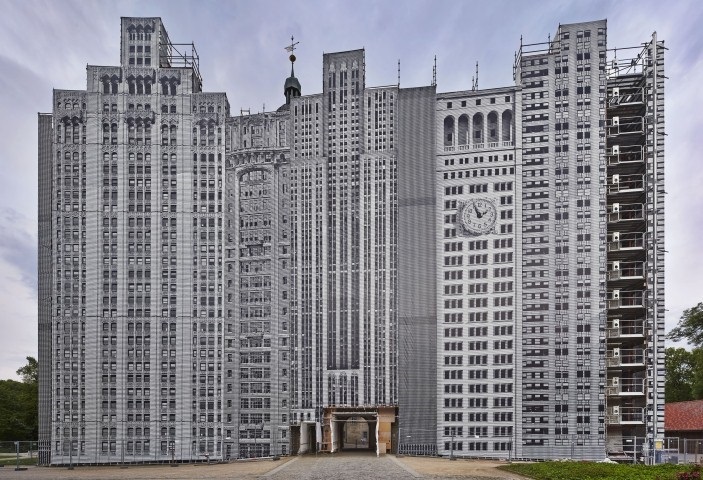
Exhibitions in the Municipal Gallery
The City of Wolfsburg's art prize "Junge Stadt sieht Junge Kunst" (Young City sees Young Art) was established in 1959 and is awarded every three years to artists who have achieved national attention with their previous work.
-
Permanent exhibitions
Bernhard Martin "Ode to Forgetfulness"
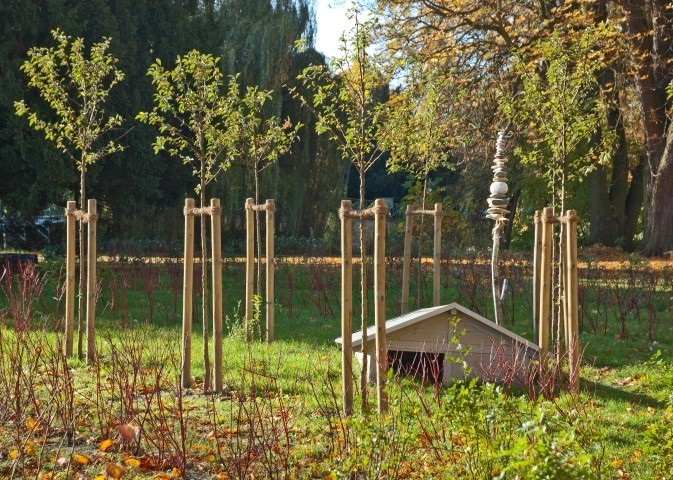 Photo: Bernhard Martin "Ode to Forgetfulness" 2013, sculpture and maze © Bernhard Martin/VG Bild-Kunst, Bonn 2019, Courtesy Städtische Galerie Wolfsburg, Photo: W. Heimermann
Photo: Bernhard Martin "Ode to Forgetfulness" 2013, sculpture and maze © Bernhard Martin/VG Bild-Kunst, Bonn 2019, Courtesy Städtische Galerie Wolfsburg, Photo: W. HeimermannSculpture and maze in the castle park
A sculpture has been created in the park of Wolfsburg Castle to appeal to young and old alike. Wolfsburg Palace is surrounded by an English landscape park on the east side and a baroque garden on the north side. The parks traditionally combine nature and art. Bernhard Martin (*1966 in Hanover) has designed a garden arbor that seems to have sunk into the earth, with just the roof peeking out. Pertly, a branch grows out of the roof, crowned by an unexpected element, a fashionable shoe. And around this surreal sculpture a small labyrinth was created, consisting of hedge plants with different flowering phases.
Olaf Nicolai "The Flame of Revolution, lying (in Wolfsburg)" Space Installation
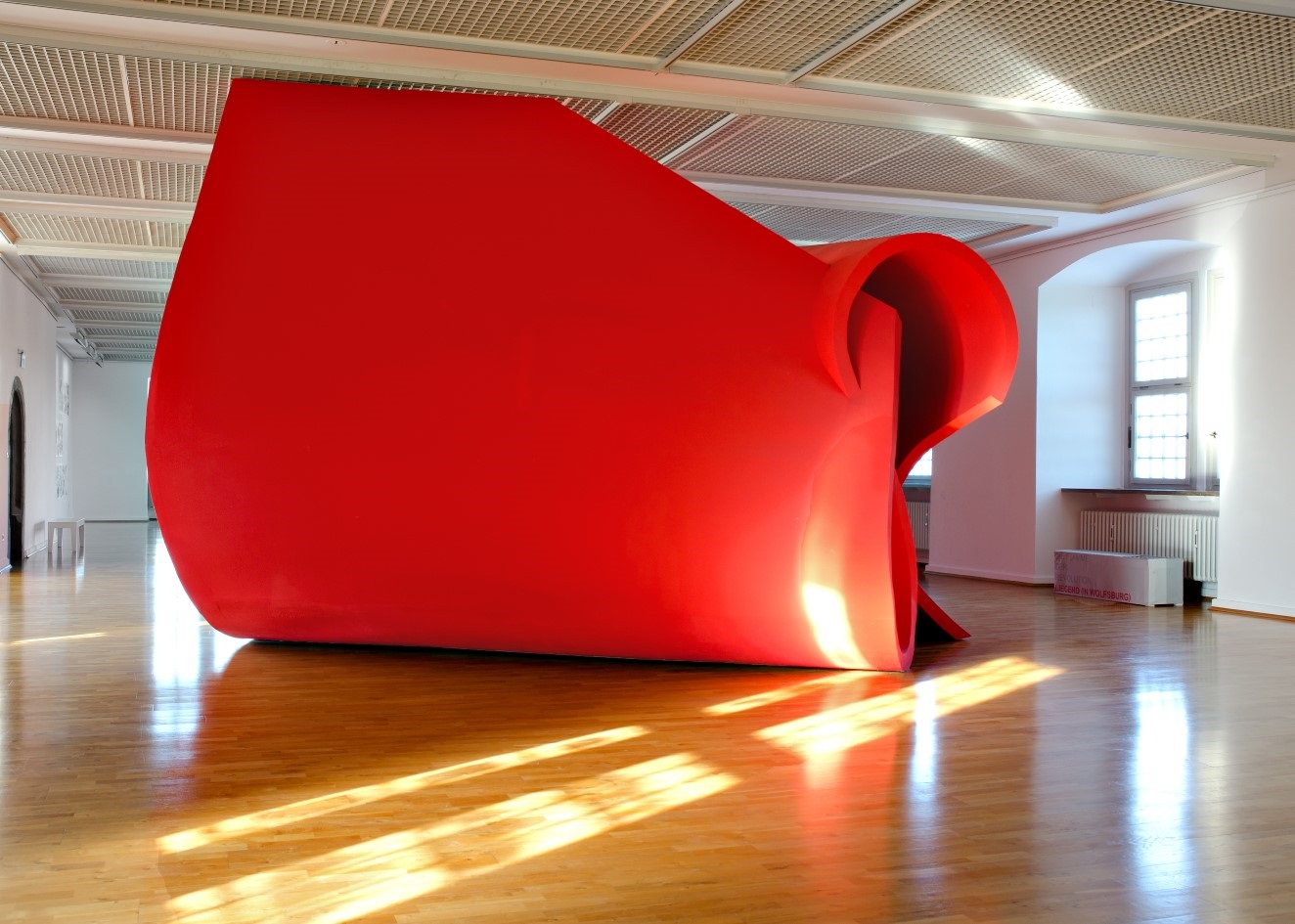 Photo: Olaf Nicolai "The Flame of the Revolution, lying (in Wolfsburg)" 2002, room installation © Olaf Nicolai/VG Bild-Kunst, Bonn 2018; Courtesy Städtische Galerie Wolfsburg, Photo: W. Heimermann
Photo: Olaf Nicolai "The Flame of the Revolution, lying (in Wolfsburg)" 2002, room installation © Olaf Nicolai/VG Bild-Kunst, Bonn 2018; Courtesy Städtische Galerie Wolfsburg, Photo: W. HeimermannThe room-sized work of art was presented for the first time in 2002 at the award ceremony for the City of Wolfsburg's "Young City Sees Young Art" art prize. By naming Olaf Nicolai the prize winner at that time, the jury paid tribute to one of the most important contemporary German artists. By alluding to a sculpture created for outdoor use and permanently presented at the Städtische Galerie Wolfsburg, Nicolai formulates the connection between formal procedures and the constitution of meanings in a way that is characteristic of his work. Olaf Nicolai (*1962 in Halle, lives and works in Berlin) studied German and literature before turning to the visual arts.
The artwork was extensively restored and can now be seen again in a permanent exhibition.
Olaf Nicolai "The Flame of Revolution, lying (in Wolfsburg)" Space Installation
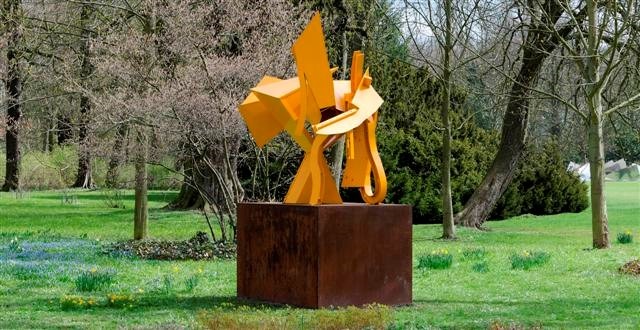 Photo: Thomas Kiesewetter "Broken Butterfly" 2011, stainless steel painted © Thomas Kiesewetter/Courtesy Contemporary Fine Arts, Berlin; Photo: Christian Dootz
Photo: Thomas Kiesewetter "Broken Butterfly" 2011, stainless steel painted © Thomas Kiesewetter/Courtesy Contemporary Fine Arts, Berlin; Photo: Christian DootzThomas Kiesewetter
With large-format sculptures by (*1963 in Kassel), the Städtische Galerie Wolfsburg presents unusual views and sights in the Schlosspark and thus shows the artist's first intervention in public space in Germany. Open vistas and compact volumes, generosity and small-scale precision, light forms and heavy metal - Thomas Kiesewetter's sculptures live from dissonances.
Art Station at Wolfsburg Central Station:
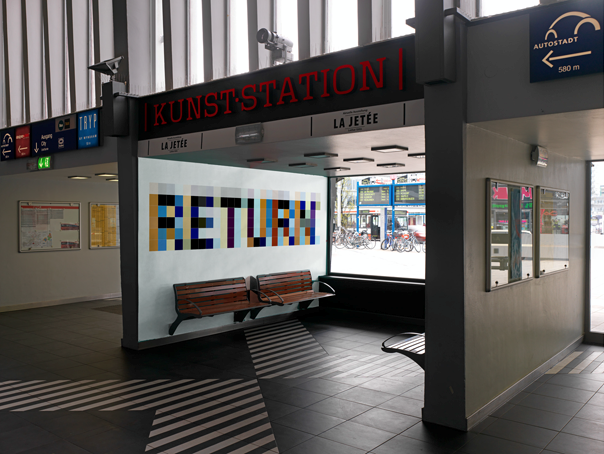 Sinta Werner "RETURN / ENTER" Design of the wall tile work in the KUNST-STATION at Wolfsburg Central Station, 2019 © Sinta Werner
Sinta Werner "RETURN / ENTER" Design of the wall tile work in the KUNST-STATION at Wolfsburg Central Station, 2019 © Sinta Werner28.08.2019 until 15.03.2020
Sinta Werner "RETURN / ENTER" wall tile work.
Exhibition opening and summer party at the Mittellandkanal on August 28, 2019 at 6 p.m.
Sinta Werner's art plays with the relationship between two- and three-dimensionality, reality and image, physical presence and projection, and the interlocking of virtual and real space. The artist explores the mechanisms of perception through deliberate deceptive maneuvers in space. The play with dimensions, but also with architecture itself, is central to her installations. In her photo collages, installations and sculptures, she also deals with the question of what influence new technologies have on our sense of spatiality. Where are we when we are on the net?
For the KUNST-STATION, Sinta Werner realizes for the first time a wall tile work and on one side of each of the lounge areas are the terms Return and Enter in pixelated tile aesthetics. The pair of terms "Return / Enter" is on the one hand familiar from the computer keyboard, but can also be read synonymously for the process of traveling: returning to a place, entering another place.
Sinta Werner (*1977 in Hattingen) studied at Goldsmiths College, London, at the Hochschule der Künste, Berlin and at the Universität der Künste, Berlin. She lives and works in Berlin. She is represented with her exhibition concepts in inter-national projects.
An exhibition in cooperation with Deutsche Bahn and Neuland Wohnungsgesellschaft.
-
Art and projects
Art connects
"Workplace Museum
The Städtische Galerie Wolfsburg sees itself as a cultural service provider. We welcome visitors as guests who should feel comfortable with us. Our goal is to stimulate a deeper engagement with art. All staff members act as intermediaries to the audience. The as Bazon Brock defines it, challenges not only the employees but also the visitors of the Städtische Galerie in the sense of an active participation and offers an open space for individual insights.
We want to be a house for all people and open the way to the exhibitions and activities without restrictions. Through predominantly free offers, all interested people should have the chance to participate. An important concern for us is the participation of people with disabilities in cultural and public life.
The founding impulse for the establishment of the Städtische Galerie Wolfsburg was the desire to develop social impact through artistic production. It is therefore important to offer artists the opportunity to work freely in our gallery and to support this work in the long term. -
Collection
From wall decoration to art collection
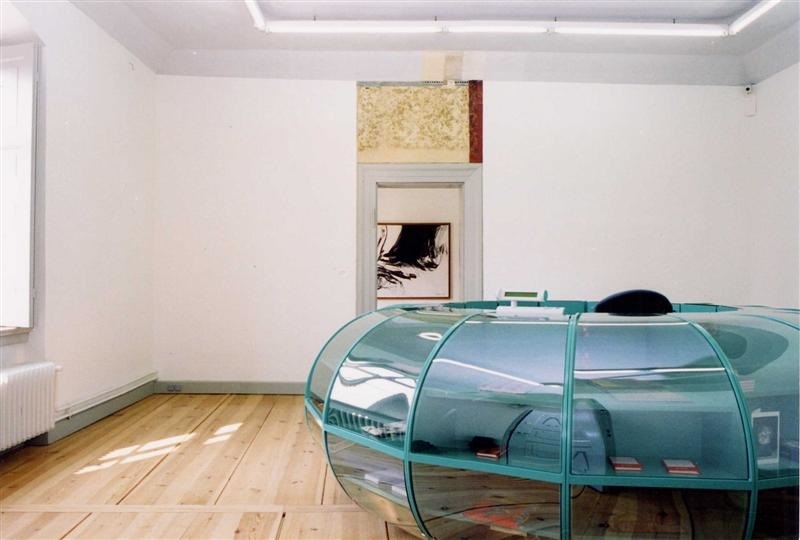 Photo: W. Heimermann/Courtesy Städtische Galerie Wolfsburg
Photo: W. Heimermann/Courtesy Städtische Galerie WolfsburgHalf a century ago, the city of Wolfsburg began purchasing art. Initially intended as wall decorations for the offices, the collected works soon developed into an art collection that has its own distinctive profile. The focus of the collection is on works from the field of German art.
-
Mediation
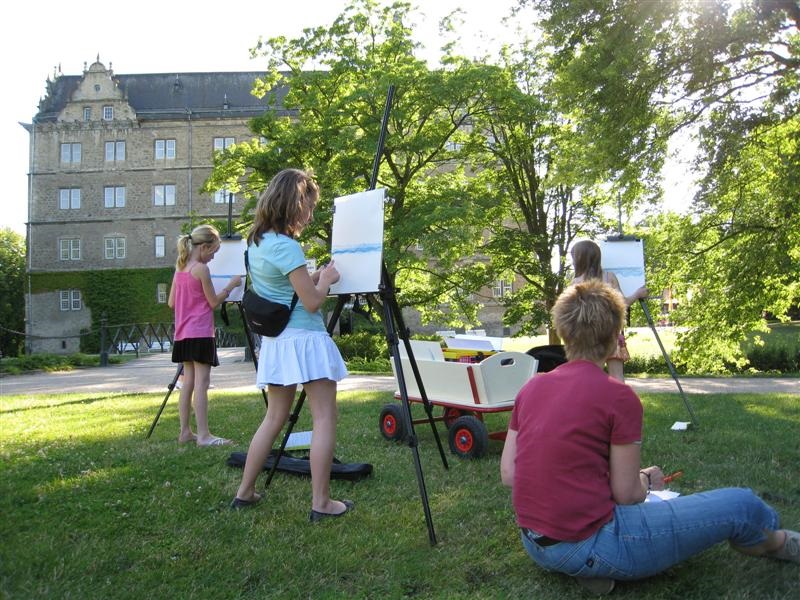 Courtesy Städtische Galerie Wolfsburg
Courtesy Städtische Galerie WolfsburgThe mediation program of the Städtische Galerie understands the visitors - young and old - as active creators of learning processes. The aim of all events is to be motivating in the communication of ideas, to show possibilities of artistic and creative forms of expression and thus to promote the ability to shape one's own environment, one's own life.
-
Archive
Here you have the opportunity to view the diverse previous exhibitions of the Municipal Gallery
